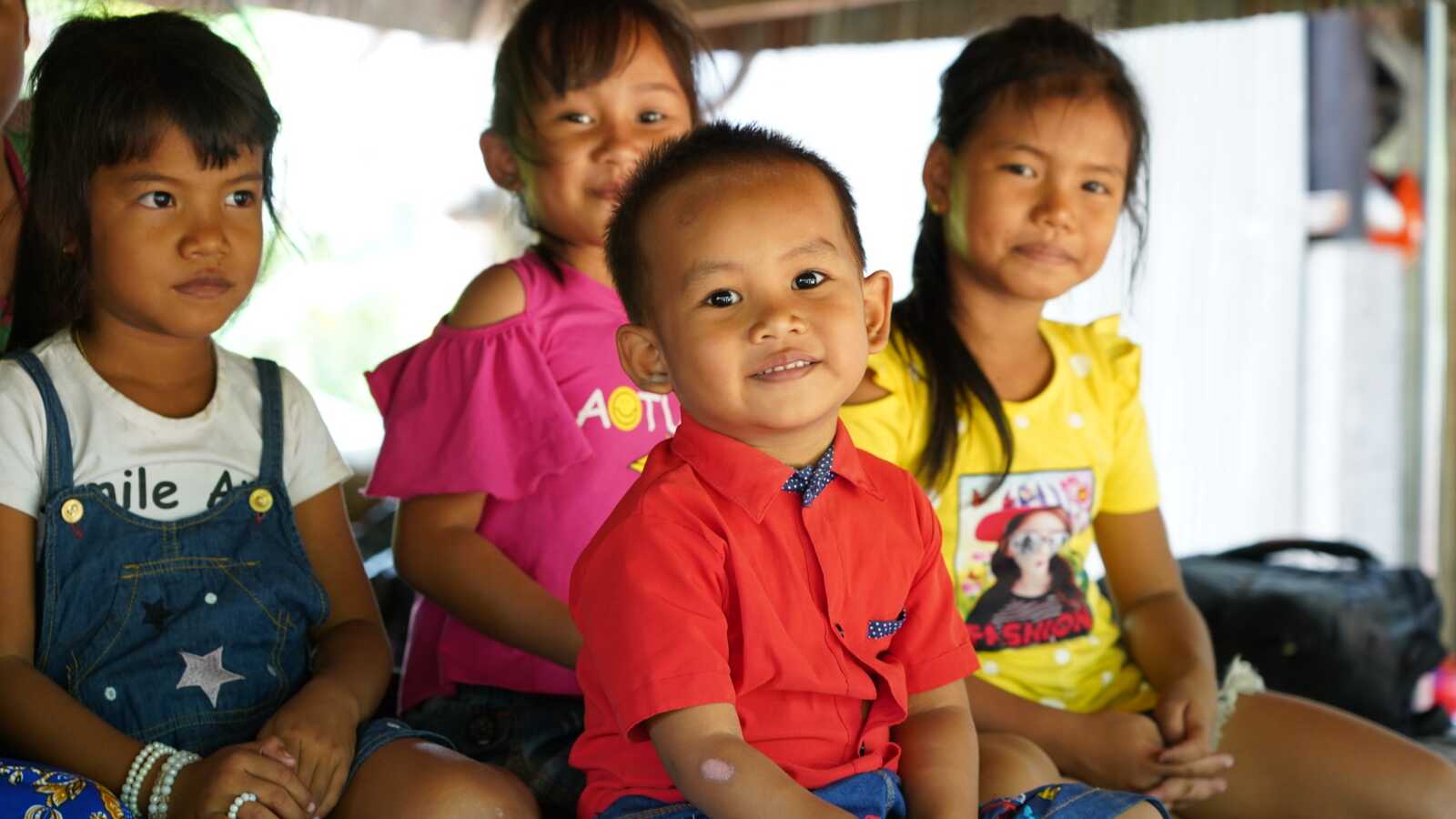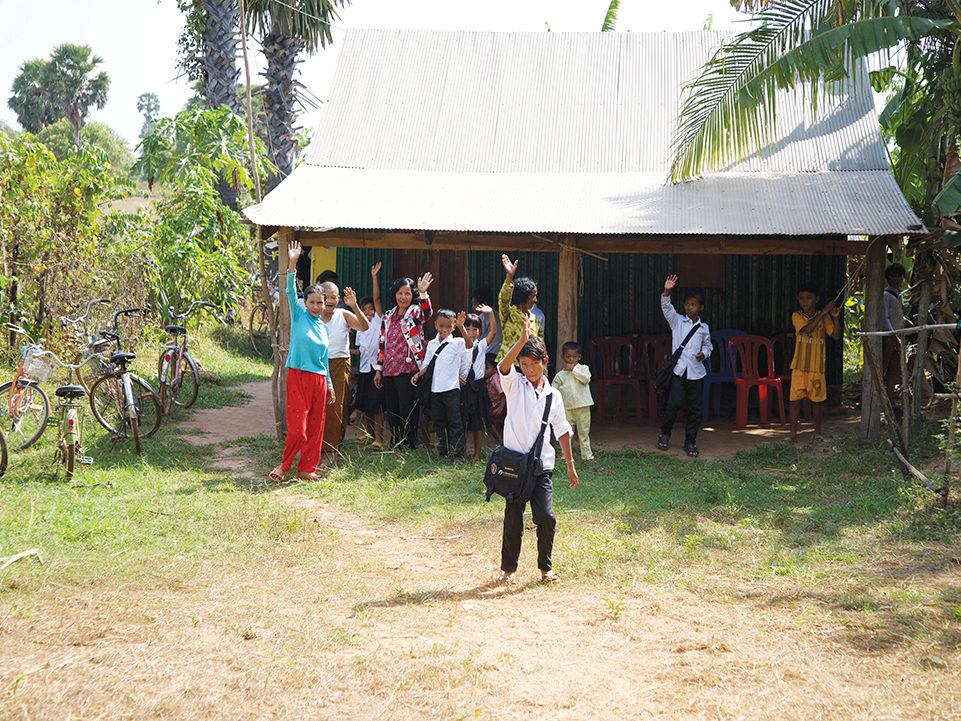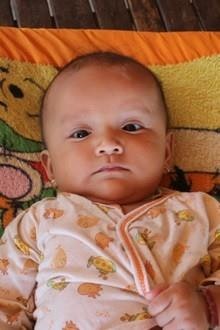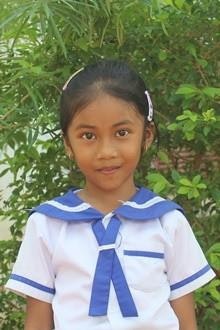If you sponsor — or are thinking about sponsoring — a child in Cambodia, here are some facts to help you learn about this ancient nation, its land and its people.
Cambodia is a country in Southeast Asia bordered by Thailand to the west, Laos to the north, Vietnam to the east and the Gulf of Thailand to the south. It is home to rice paddies and forests; the Tonlé Sap, Southeast Asia’s largest freshwater lake; and the Mekong River, the third-longest river in Asia.
Roughly 80 percent of Cambodians live in rural areas, often in traditional houses built on stilts. These houses provide refuge from floodwaters in the rainy season and allow air circulation to flow in the dry season.
Cambodia is among the most ethnically and religiously homogenous nations in Southeast Asia. More than 95 percent of its residents are Khmer, and about 97 percent are Buddhist. Its national flag features at its center the ancient temple of Angkor Wat, built in the 12th century.
Between 1975 and 1979, Cambodia faced a particularly bloody period in its history, when the Khmer Rouge — a brutal Communist-led regime — killed more than 2 million Cambodians. Those killed were either executed as enemies of the government or died from starvation, disease or overwork. Historically, this period has come to be known as the Cambodian Genocide.
Cambodia is among the most ethnically and religiously homogenous nations in Southeast Asia. More than 95 percent of its residents are Khmer, and about 97 percent are Buddhist.
Decades later, Cambodia still struggles to rebuild its society from these bloody years, dealing with issues of pervasive poverty, gender inequality, food insecurity and mass migration from rural areas as people seek work in cities. Cambodia also has a very young population, with a median age of 26 — an outcome of the Cambodian genocide that decimated so much of the population.
Holt’s legacy of helping Cambodian children and families began in the 1970s when our partner in Thailand helped care for Cambodian refugee children who fled across the border during the Vietnam War. In the 1990s, Holt began working within Cambodia — developing programs for children living in refugee camps and institutions as well as children and families at risk of separation.
While ongoing instability in the region caused Holt to leave Cambodia in the mid-1990s, Holt returned in 2005 to provide care for orphaned and vulnerable children and to help strengthen families in Cambodia. Every year, sponsors and donors provide life-changing support for roughly 7,000 children and families in the region.

Basic Facts About Cambodia
Capital
Phnom Penh
Population
17.8 million people (est.)
Official Language
Khmer
Area
68,898 square miles, slightly smaller than Oklahoma
Climate
Cambodia has a tropical climate, with annual temperatures averaging between 80°-100° F. The dry season extends from December to April, the hottest month. The rainy season is from May to November, the coolest month. October is the wettest month.
Religion
Buddhist, 97.1% (Buddhism is the official religion of Cambodia); Muslim, 2%; Christian, 0.3%; other, 0.5%
Ethnic Groups
Khmer, 95.4%; Cham, 2.4%; Chinese, 1.5%; other, 0.7%
Type of Government
Parliamentary constitutional monarchy

National Celebrations
Cambodian holidays are often tied to the beginning or end of a harvest season, days of importance in the nation’s history or to the celebration of one’s ancestors.
Khmer New Year is the most widely celebrated holiday in Cambodia. It takes place over three days in mid-April, at the end of the spring harvest season. On the first day, known as Maha Sangkran, Cambodians clean and decorate their homes in preparation for the new year. The second day is called Virak Wanabat, or “day of giving.” On this day, Cambodians bring gifts to their parents, grandparents and elders. They also deliver offerings to those in need. On the third day, Leung Sakk, Cambodians hold cleansing ceremonies to seek forgiveness for any past misdeeds and pray for good luck and prosperity in the new year.
Over the Khmer New Year, families often gather together at the eldest member’s house to eat, visit and play games, such as teang prut (tug-of-war) or leak konsaeng (hide the scarf). Cambodians also take to the streets to douse each other with water and talcum powder in a raucous but friendly celebration.
Khmer New Year is the most widely celebrated holiday in Cambodia. It takes place over three days in mid-April, at the end of the spring harvest season.
Bun Om Thouk, or “water festival,” celebrates the end of the rainy season. It begins on the night of the full moon in November. People from around Cambodia come to the banks of the Tonlé Sap and Mekong rivers in Phnom Penh to watch more than 2,500 paddlers take part in traditional boat races.
In addition to boat racing, the festival includes three ceremonies: Bandet Pratip (“illuminated float”), a procession of boats; Sampeas Preah Khe (“salutations to the moon”), an offering of thanks and prayers for the coming harvest; and Ork Ambok (“eating of the rice flakes”), a gathering at midnight to eat ambok, flattened rice with banana and coconut juice.
Cambodian Greetings
Placing one’s hands together in a prayer position at chest level is a form of greeting in Cambodia. The higher the hands are held, the greater the sign of respect. This gesture, known as sampeah, is accompanied by a slight bow to show respect for one’s elders or those of higher status.
Cambodian Food & Drink
Cambodian cuisine is influenced by Chinese, Indian and European cultures. It generally is less spicy than food in Thailand and other neighboring countries. Cambodians rely on staples such as rice, rice noodles, freshwater fish and vegetables. Prahok, a salted and fermented fish paste, is used as a seasoning or condiment and eaten with nearly every meal. Cambodians also enjoy iced coffee, prepared with condensed milk.
Some common dishes include:
- Fish amok, made from fish, coconut milk and curry paste, and served in banana leaves
- Samlor korko, a thick soup made with catfish, pork or chicken, roasted ground rice, vegetables, fruit, kroeung (a spice paste) and prahok (a fish paste)
- Nom banh chok, a rice noodle dish often eaten for breakfast
- Bai sach chrouk, a breakfast dish made from thinly sliced pork, marinated in palm sugar and fish sauce, and served over white rice
- Bok trop pgnon, an eggplant dip made from bitter, pea-size eggplants, grilled and pounded with garlic, shallots, chilis and sugar. The dip is served alongside fresh or steamed vegetables.
- Kha sach ko, beef stewed in palm sugar
- Sngor chruak sach trei, a fish soup that contains a light lemongrass broth, seasoned with lime juice, fried garlic and herbs
Mealtime Customs
- Most Cambodians eat three meals a day. Dinner is the main meal.
- Cambodians eat with spoons, forks, chopsticks or their fingers, depending on the food and family customs.
- The Khmer often use spoons and forks, while Cambodians of Chinese descent use chopsticks. Fewer people today eat with their fingers.
- In rural homes, family members gather around a mat and eat from a common platter. When seated on the floor, elders will cross their legs and children will tuck their feet to the side with their toes pointed behind them.

Social Concerns
Poverty
Many children in Cambodia live in poverty without enough food or safe housing. Poverty is most prevalent in rural areas, striking single mother and female-led households the hardest. That’s because many women living in rural areas — especially those who lived through the Khmer Rouge regime of 1975-79 — received little or no education as children and may not have any formal job skills training.
Learn how Holt sponsors and donors help struggling single mothers and families care for their children in Cambodia.

Help Children & Families in Cambodia
Many children in Cambodia live in poverty without enough food or safe housing. Children are at risk of separation from their parents who migrate to find work. Without a stable family, they’re in danger of trafficking, exploitation or being sent to live in an orphanage. Your gift will help a child or family in Cambodia in greatest need.
Migration
Poverty rates in Cambodia vary considerably by area. The poverty rate is the lowest in Phnom Penh (4.2 percent) and other urban areas (12.6 percent), and the highest in rural areas (22.8 percent). As a result, thousands of families migrate to cities each year in search of jobs. Men often work in the construction industry, while women often find jobs working in garment factories. Cambodians may also migrate across the Thai border or into other countries where they can find work more easily.
Poverty rates in Cambodia vary considerably by area. The poverty rate is the lowest in Phnom Penh (4.2 percent) and the highest in rural areas (22.8 percent).
Families who migrate long distances from home often have no choice but to leave their children in the care of relatives or elderly grandparents, many of whom can barely afford to feed themselves. Children who are left behind, without the attention of their parents, are at greater risk of dropping out of school — and are vulnerable to abuse, hunger, child labor and trafficking.
Children who migrate with their parents also face numerous dangers. Once families arrive in bustling cities, they often live in perilous slum communities, where children can easily fall prey to predators — especially when parents are forced to work long hours in order to earn a living wage.
Learn more about how migration endangers children and how Holt sponsors and donors can help.
Girls’ Education
Due to reforms in the education system, the literacy rate in Cambodia is rising. In 2024, about 85 percent of Cambodians ages 7 and older were considered literate in the Khmer language, meaning they had the ability to read and write ordinary phrases with comprehension. Still, fewer females than males in Cambodia today are literate. One reason may be that girls — particularly those in rural areas — drop out of school sooner than boys, sometimes as early as grade six. As in many developing countries, parents will prioritize their sons’ education over their daughters’, particularly if a family lives in poverty and cannot afford to send all their children to school. Girls who drop out of school become more vulnerable to ongoing poverty, abuse and exploitation.
To address these concerns, Holt Cambodia has implemented a support program to increase access to education for vulnerable children at risk of dropping out of school. Through the program, students receive support to complete at least nine years of compulsory education. In addition, Holt supports children in remote areas of Cambodia to access early education and development programs through our community preschools.
Learn how Holt donors and sponsors help girls — and boys — in Cambodia further their education.

Malnutrition
In rural Cambodia, many children and families survive on what they grow to eat — staples like rice, melons and other vegetables. But drought is common, causing food and water shortages that can lead to malnutrition and hunger-related diseases. In 2019, a drought in Cambodia damaged more than 176,000 acres of rice fields. Rice is Cambodia’s most important agricultural crop as well as a major food staple.
In recent years, Cambodia has made significant progress in the lives of its children. Between 2014 and 2021, the rate of stunting among children under 5 declined from 32 percent to 22 percent, according to a recent UNICEF report. (Stunting occurs when children are too short for their age.) However, one in 10 children under 5 continues to suffer from wasting, meaning that they do not weigh enough for their height. Wasting is one of the most life-threatening forms of malnutrition, according to UNICEF. Many factors lead to malnutrition, including poverty, poor water, sanitation and hygiene practices, limited education and lack of knowledge about proper nutrition and feeding.
Learn how Holt sponsors and donors provide families in Cambodia with the emergency food and nutritional help they need.
Holt Sponsors Help Children in Cambodia Thrive in the Love of a Family
In Cambodia, nearly 80 percent of children living in orphanages have at least one living parent. When parents face a crisis, it’s common practice to place their child in a care facility in the hope that they will at least receive food and an education. As a result, thousands of Cambodian children are currently living in institutionalized care.

But at Holt, we strive to help every child grow and thrive in the love of a family. In 2016, Holt began working alongside local partners to develop more nurturing care alternatives for the thousands of children living in Cambodia’s institutional care centers. These alternatives include three care models — kinship care, foster care and, for the first time, a formal, ethical system of domestic adoption. Through these three pilot programs, Holt sponsors and donors help children reunite with their birth families or join foster or adoptive families in Cambodia.
Learn how Holt sponsors and donors help provide nurturing care alternatives for children in institutionalized care.
Read more stories about how sponsors and donors help children thrive in Cambodia.

Learn more about Holt’s work in Cambodia!
See how sponsors and donors create a brighter, more hopeful future for children and families in Cambodia!





